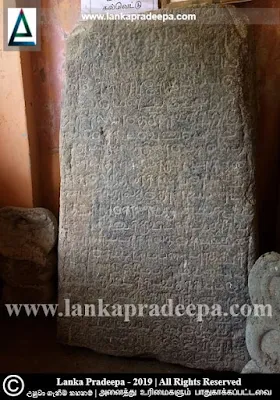
Nagapooshani Amman Temple/ Kovil (Tamil: நயினாதீவு நாகபூசணி அம்மன் கோயில்; Sinhala: නාගපූෂණී අම්මාන් කෝවිල) is a famous Hindu shrine situated on the island of Nainativu (or Nagadeepa/ Nagadipa) in Jaffna District, Sri Lanka. The temple is dedicated to the Hindu goddess Parvathi who is known as Nagapooshani or Buwaneshwari and her consort, Shiva who is named Rakshseshwar or Nayinar (Hewapaththuwa et al., 2018).
Presently, the temple is venerated by the people of all religions, mainly by the Hindu devotees.
History
Nagadeepa
Nagadeepa is referred to as Nainativu or Manipallavam or Maninaga Island as well (Dias et al., 2016). The place is mentioned in several early Sri Lankan chronicles such as Dipavamsa and Mahavamsa and in ancient Tamil Sangam literature of Tamil Nadu (India) such as Manimekalai and Kundalakesi (Dias et al., 2016; Hewapaththuwa et al., 2018).
Nagadeepa is referred to as Nainativu or Manipallavam or Maninaga Island as well (Dias et al., 2016). The place is mentioned in several early Sri Lankan chronicles such as Dipavamsa and Mahavamsa and in ancient Tamil Sangam literature of Tamil Nadu (India) such as Manimekalai and Kundalakesi (Dias et al., 2016; Hewapaththuwa et al., 2018).
Literary mentions
The temple is mentioned in Shakthi Peetha Stotram written by Adi Shankarcharya, an 8th-century Hindu philosopher. Therefore, this temple is considered today as one of the prominent 64 Shakti Peethas (one of the 64 mighty places of the goddess Ambhal) in the Indian sub-continent (Hewapaththuwa et al., 2018).
Legends
 According to Hindu mythology, the Nagapooshani Amman temple is standing today on the site where the anklet of Mata Suti was fallen when her dead body was cut into 52 parts by Vishnu (Hewapaththuwa et al., 2018).
According to Hindu mythology, the Nagapooshani Amman temple is standing today on the site where the anklet of Mata Suti was fallen when her dead body was cut into 52 parts by Vishnu (Hewapaththuwa et al., 2018).
According to another legend, two merchants Manayakan and Mahasathavan who were sailing through the sea had seen an eagle (or vulture) preventing the way of a cobra swimming across the sea towards Nainativu with a flower in its mouth, for the worship of the divine on the island (Arumugam, 1991). The merchants asked the eagle to let the cobra go on its way without any harm. The eagle agreed to the merchants' request but asked him to build a beautiful temple for Sri Bhuvaneshwari Amman on the island of Nainathivu if he wanted to let the cobra go free. The merchants agreed to that request and built a beautiful temple accordingly (Dias et al., 2016; Hewapaththuwa et al., 2018).
Destruction
The temple which had been later developed by one Veerasami Chettiyar (Arumugam, 1991) was looted and destroyed in 1620 or 1625 after the Portuguese assumed control over the Jaffna peninsula (Arumugam, 1991; Dias et al., 2016). Subsequently, a small temple was erected at the same site by a person named Ramalingam Ramachandranal of the Pattar community (Dias et al., 2016). The temple confronted another threat of destruction by the Dutch but it was prevented by Kadirithambi, a Pattar, by convincing them that the temple is not a Hindu shrine but a church of the Mother Goddess (Dias et al., 2016).
Modern temple
The present temple was established at the site in 1882, during the era of the revival of Hinduism spearheaded by Arumuga Navalar (Arumugam, 1991). A Rajagopuram was erected in the temple in 1935, and its East Gopuram was constructed in 1951 (Arumugam, 1991; Dias et al., 2016). The management of the affairs of the temple came under a Trustee Board in 1949 (Arumugam, 1991).
A stone slab containing a Tamil inscription has been unearthed from the premises of the Nagapooshani Amman temple (Dias et al., 2016; Indrapala, 1963). This epigraph is considered an important archaeological heritage found in Jaffna Peninsula as it reveals the commercial activities that existed in ancient times (Dias et al., 2016).
The slab is about 4 feet in height and 2 feet 5 inches in width. It has been written in Tamil scripts interspersed with Grantha (Indrapala, 1963). As mentioned in the inscription itself, it has been indited by King Parakramabahu I (1123-1186 A.D.) to proclaim that the foreigners who disembark from their ships at Uratturai port (present Kayts) will remain under the security of the state. It further says that the foreigners who disembark from any other port should be assembled in the Uratturai port premises and the ships that suffer wreckage in transit through the waters of the port will be charged based on the type of cargo by the state treasury (Dias et al., 2016; Indrapala, 1963).
Presently the slab is placed in the museum of Nagapooshani Amman temple with other artefacts and ancient coins discovered on the temple premises (Dias et al., 2016).


.
References
1) Arumugam, S., 1991. More Hindu temples of Sri Lanka. London. pp.49-50.
2) Dias, M.; Koralage, S.B.; Asanga, K., 2016. The archaeological heritage of Jaffna peninsula. Department of Archaeology. Colombo. pp.163,201-202,209-210.
3) Hewapaththuwa, H.P.M., Rupasinghe, R.M.W.K.R. and Herath, H.M.A.S., 2018. Connection of Valluvar community to Naaga and Shakthi worship related to Nainativu Nagapooshani Amman Temple: A Historical Review. pp.85-87.
4) Indrapala, K., 1963. The Nainativu Tamil Inscription of Parakramabahu I. University of Ceylon Review. Vol. XXI; No, I. University of Ceylon. Peradeniya. pp.63-70.
2) Dias, M.; Koralage, S.B.; Asanga, K., 2016. The archaeological heritage of Jaffna peninsula. Department of Archaeology. Colombo. pp.163,201-202,209-210.
3) Hewapaththuwa, H.P.M., Rupasinghe, R.M.W.K.R. and Herath, H.M.A.S., 2018. Connection of Valluvar community to Naaga and Shakthi worship related to Nainativu Nagapooshani Amman Temple: A Historical Review. pp.85-87.
4) Indrapala, K., 1963. The Nainativu Tamil Inscription of Parakramabahu I. University of Ceylon Review. Vol. XXI; No, I. University of Ceylon. Peradeniya. pp.63-70.
Location Map
This page was last updated on 26 April 2023


